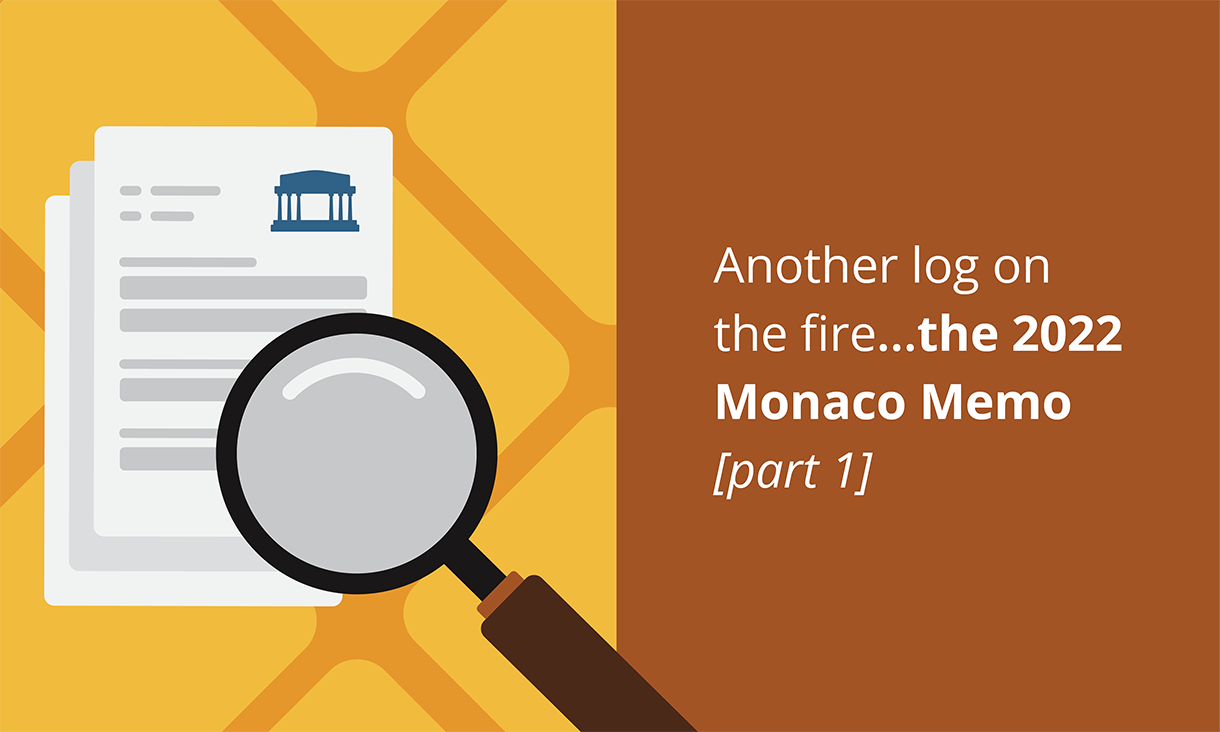
Another log on the fire…the 2022 Monaco Memo [part 1]
Last fall, Deputy Attorney General Lisa Monaco issued a follow-up to her October 2021 memo on the DOJ's existing corporate criminal enforcement policies and practices. This memo was designed and written as guidance to prosecutors on a defendant’s accountability, and instructs an evaluation of the defendant’s:
- History of misconduct
- Self-disclosure and cooperation
- Existing compliance program
As you know, dear compliance friends, these memos provide us with a wealth of insight into what the DOJ is thinking and how they expect our programs to function. We also know these guidance documents are somewhat difficult to navigate. There are TONS of breakdowns to read and examine, and I highly encourage you to do so. The more thoughts and ideas in the marketplace, the better!
Think about this memo in three high-level parts: accountability, assessment, and application of corrective actions. I’ll break down each and give you my notes on where to focus your attention.
If I had to sum up the memo in one word, it would be: "accountability."
The DOJ focuses on personal and corporate accountability and moves swiftly into telling us how to prove it. And not just what you HAVE been doing, but what you ARE doing now (e.g., timely notification to prosecutors: “once discovered” vs. “delay inhibited investigation”). So be ready to produce documentation (or, in legal speak, “facts and evidence”) for the time period of the misconduct. This means your documentation about what’s happening NOW needs to be tight. After all, you can’t go back in time to fix bad documentation, but you can get better at it starting today.

Additionally, your demonstration of accountability extends to how you’re responding to the DOJ’s requests. It’s all about the spirit of the request, not the specificity. For the lawyers out there, this is going to be a very hard pill to swallow. Providing things that weren’t specifically asked for goes against nearly everything you were taught in law school. However, that’s exactly what the DOJ expects.
There is no more forgetting the past. Prosecutors will also actively consider past misconduct—criminal, civil, and regulatory actions—in all jurisdictions.
And you’re going to need to do the work to show them this history. Be ready to produce a summary of all prior criminal resolutions in the last 10 years, civil/regulatory resolutions in the last 5 years, and any known pending investigations by any jurisdictional authority.
Make sure to include:
- Form of resolution
- Associated sanctions or penalties
- Elapsed time
- Facts and circumstances
- Factual admissions
- Similarity in nature (even if prosecuted under a different statute)
- Probationary status (supervision, monitorship, other resolution obligation)
Prosecutors are expected to weigh each of these factors, with more weight applied to recent criminal resolutions, the same parties involved in the current misconduct, or the same root cause. That last one’s no foolin’.
That’s not all. Individuals will be targeted. Prosecutors will seek individual criminal charges—prior to or simultaneously—with a corporate resolution. Your leadership team in particular needs to be on notice about this (including you!), and be ready to defend on multiple fronts. Over time, It’ll be interesting to see which jurisdictions the DOJ defers to, or not, as they determine whether an effective prosecution will occur in another jurisdiction.
All this being said, voluntary disclosures are still highly encouraged (even if you’ve got a record). The carrot is that guilty pleas won’t be sought, and independent monitors won’t be required. The stick is that you have to do everything right in the process to get those rewards. An uphill climb, for sure.
Here's what to take away from this part of the memo:
📝 Perfect your document retention skills and, when asked to produce docs, don’t be too literal about what the request says.
Pro-tip: Footnotes are your friends!1 Read them! They are GOLD! The footnote in the memo tells you exactly what records they want you to keep—so if you don’t already have it, get it and organize it.
⏰ Be prompt, even when you’re not super comfortable with what you’re handing over.
🧦 Learn your company’s history before your dirty laundry is aired. Part of understanding the past includes knowing what the outcomes were (not just the juicy stories); this means that you’ll ALSO need to know what you did to address those past issues, and whether or not you stubbed your toe on any of them.
📆 Start with the recent past and work backwards if you’ve got limited time or resources. Recent stuff, same people or same actions (or inactions) are the focus.
🤕 Own up to your stumbles, even if you’re still dealing with them.
NOW TAKE A DEEP BREATH. That’s all we’re gonna cover for today.
Please tune in next week for part 2 of our breakdown of the Monaco Memo, when we cover HOW your program is going to be picked apart.
1 Told you footnotes were important! Click here to download our free visual breakdown of the Monaco Memo.

